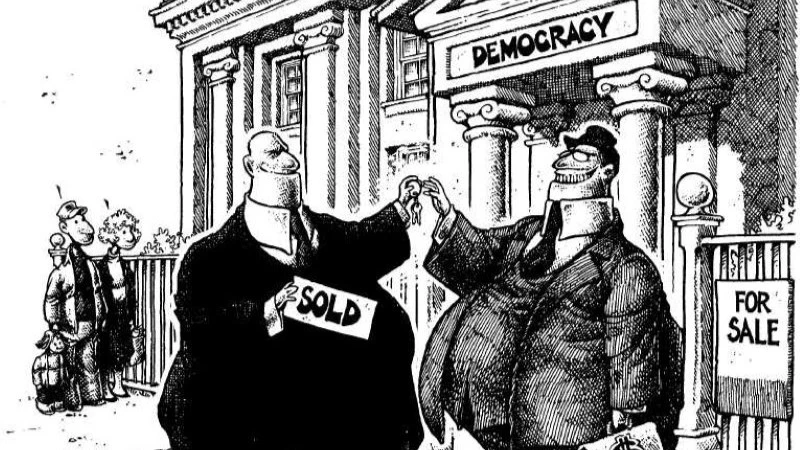NSPM-7 and Fascism (and What It Means to be an Anti-Fascist)
Looking at how Trump’s NSPM-7 memo weaponizes the concept of “anti-fascism” to suppress dissent and dissecting what fascism truly means in today’s political landscape.

This is part two in my series on NSPM-7. You can read part one here: “NSPM-7 and Capitalism (and What It Means to be an Anti-Capitalist)”
There are common recurrent motivations and indicia uniting this pattern of violent and terroristic activities under the umbrella of self-described “anti-fascism.” These movements portray foundational American principles (e.g., support for law enforcement and border control) as “fascist” to justify and encourage acts of violent revolution. This “anti-fascist” lie has become the organizing rallying cry used by domestic terrorists to wage a violent assault against democratic institutions, constitutional rights, and fundamental American liberties. Common threads animating this violent conduct include anti-Americanism, anti-capitalism, and anti-Christianity; support for the overthrow of the United States Government; extremism on migration, race, and gender; and hostility towards those who hold traditional American views on family, religion, and morality.
Most social revolutions begin peaceably. Why would it be otherwise? Who would not prefer to assemble and demonstrate rather than engage in mortal combat against pitiless forces that enjoy every advantage in mobility and firepower? Revolutions in Russia, China, Vietnam, and El Salvador all began peacefully, with crowds of peasants and workers launching nonviolent protests only to be met with violent oppression from the authorities. Peaceful protest and reform are exactly what the people are denied by the ruling oligarchs. The dissidents who continue to fight back, who try to defend themselves from the oligarchs’ repressive fury, are then called “violent revolutionaries” and “terrorists.”
It’s 2025, and the world is still unfortunately talking about fascism. I’ve read a decent bit on fascism[1] since Trump first entered office in 2016. And while I’m not an expert on the subject, I feel I know enough about it now to write about it in regards to Trump’s September 25th national security presidential memorandum (NSPM-7) titled “Countering Domestic Terrorism and Organized Political Violence.”
NSPM-7 (as I covered in my first post in this series) is a national security memo from Trump’s desk that rode the wave of denunciations of political violence following the assassination of Charlie Kirk, a fascist political commentator, to advance a narrative of countering domestic terrorism tied to extreme left-wing ideologies. This is, of course, false, but Trump publishing this memo is simply further proof that he and the neckbeards who comprise his cabinet and staff are textbook fascists. Anyone who says otherwise doesn’t know what they’re talking about or is likely a fascist themselves.
NSPM-7 creates a dangerous pretext, as it’s nothing more than a way to justify suppressing political dissent amid an ongoing propaganda campaign from the Trump administration and the Republican Party to manufacture consent for forcibly and violently silencing peaceful protestors. It lays the foundation for a slew of Trumpian thoughtcrimes that would seek to label anyone who holds viewpoints deemed divergent from so-called “traditional” American views on a wide range of issues as a domestic terrorist, or at least someone who’s likely to become one.
This isn’t a new tactic, but that doesn’t make it any less alarming. It’s important to understand what’s at stake right now, and hopefully getting a better grasp of what fascism actually is will help you with that.
What’s in a fascist
The word “fascist” gets thrown around a lot these days, mostly from the left but also from the right, who are always quick to employ a favorite rhetorical move of theirs: shout, “No I’m not, you are!” when faced with any degree of clear-eyed criticism. But what is a fascist, anyway? Is it a word that can be used to describe any kind of tyrant, or is it just a satisfying word to yell at meanies so we can give ourselves a self-righteous pat on the back?
A lot of people associate the word “fascism” with “Nazism,” but the two aren’t synonymous. Every Nazi is a fascist, but not every fascist is a Nazi. Likewise, we might say every Republican is a fascist, but not every Republican is a Nazi. (Though, make no mistake, a lot of Republicans certainly are Nazis.)
For a formal definition of fascism, I defer to philosopher, professor, and author Jason Stanley, whose 2018 book How Fascism Works served as an accessible primer to many people on what the fuck was going on during Trump’s first term (or at least it did for me). It remains relevant nearly eight years later, and it broadly defines fascism like this: Fascism is a tyrannical political ideology that divides people into “us” and “them,” usually using religion, race, or ethnicity (or all three) to appeal to a glorious, mythic past that cements “us” as righteous and superior to “them” (paraphrase).
Stanley notes that the different components of fascism tend to build on each other and that American history contains shining examples of both liberal democracy and fascism. “Indeed,” Stanley writes in the introduction, “Hitler was inspired by the Confederacy and Jim Crow laws.”
Varieties of fascism
Fascism comes in different flavors, each of them as nauseating as the next. The Nazis were one flavor of fascism that appealed to (at the time) burgeoning German nationalism, anti-communism, and a fictional narrative about the noble history of Germanic or Nordic peoples. Other flavors include:
- Benito Mussolini’s misguided spin on Medieval guilds in Italy
- Augusto Pinochet’s disastrous execution of neoliberal economics in Chile[2] (policies born from the Chicago school of economics), often with personal direction and guidance from Milton Friedman himself
- Francisco Franco’s appeal to traditional Catholicism and anti-communism in Spain
We are witnessing in America today the ongoing creation of a uniquely American flavor of fascism, one that NSPM-7 codifies and synthesizes into a formal ideology. It says so right there in the memo — this American brand of fascism is marked by anti-communism, rejection of LGBTQ+ identity, Christian fundamentalism, nativism, and nationalism.
In many ways, these sentiments have always been with us, simmering in the background until they inevitably boil over at different points in our history. We’re living through one such boiling-over period right now, and history tells us it likely won’t be the last.
Antifa ate my baby
So what’s an anti-fascist? At face value, an anti-fascist is someone opposed to fascism (which ought to be all of us), but let’s peel back the top layer to take a closer look.
In the context of NSPM-7, “anti-fascist” refers to someone affiliated with Antifa, a quasi-movement with no official structure or organization, supposedly comprised of people who believe in violent confrontation with those they deem fascists and who support the overthrow of the US government through violent revolution.
Antifa might actually be pretty cool if it was a real thing, but it just isn’t — at least not in the way Trump thinks it is, which would be something akin to a drug cartel or a legit militarist organization like the Taliban. Trump is obsessed with destroying what he perceives to be Antifa, issuing an executive order on September 22nd (just days before issuing NSPM-7) designating Antifa as a domestic terrorist organization. In this executive order, Trump (look, we all know Trump isn’t smart enough to write these things himself) defines Antifa as a “…militarist, anarchist enterprise that explicitly calls for the overthrow of the United States Government, law enforcement authorities, and our system of law.”
Journalist Ken Klippenstein has been covering the war on Antifa diligently, taking care to note that previous investigations by the FBI basically turned up nothing. But under Trump’s new FBI director, a dickhead named Kash Patel, Antifa is under renewed scrutiny, with Patel saying at a September White House roundtable event, “What we are doing at the FBI is simple. We are following the money. Money never lies. And that’s what it’s going to take to bring down this network of organized criminal thugs, gang bangers, and yes, domestic terrorists because that’s what they are.”
Because the FBI can’t find any concrete evidence that Antifa exists as a real entity, it has started targeting what it calls “affinity groups” — that is, small groups that appear sympathetic to Trump’s contrived definition of Antifa — in addition to non-profit organizations and private donors who might be suspected of somehow channeling funds to a nonexistent criminal organization.
Post hoc, ergo propter hoc
This all gets back to the real danger of NSPM-7, which is that it creates a strawman version of Trump’s perceived enemies that is and will be used as a pseudo motive to systematically target and harass people that Trump just doesn’t like. The irony, of course, is that by creating a false narrative about an Antifa boogeyman, Trump provides justification for expanding and doubling down on his own fascist agenda under the guise of protecting Americans from Antifa, which, allow me to reiterate, does not exist.
This is a classic play from the fascist’s playbook of creating a state of unreality — what Jason Stanley describes as a political climate in which fake news and conspiracy theories replace reasoned debate about observable phenomena. Again, nothing Trump and his cronies are doing is new or ingenious. Fascists have been doing this shit for a long time, as they’re masters of a logical fallacy I remember learning about in 7th grade: post hoc ergo propter hoc, a Latin phrase that translates to, “after this, therefore because of this.”
These people are crafty, but they aren’t smart. Unfortunately, that makes them particularly dangerous. Post hoc ergo propter hoc reasoning is what led to tragedies like the Salem Witch Trials, in which fear-mongering about a phony threat (witches) led to the real persecution of young women whose only real crimes were likely little more than perceived slights against the patriarchal order of the day.
We all know Trump loves to play the victim, often invoking the language of witch hunts to garner sympathy for this personal and legal woes, all problems of his own making. Now the tables have turned, and anyone who might fit the description of Trump’s idea of a witch is in the crosshairs of a petty billionaire sex pest’s witch hunting party.
-
To do a little posting of my credentials, here are some of the books I’ve read on fascism in recent years, not to mention the podcasts I’ve listened to and documentaries I’ve watched on the subject:
- The Origins of Totalitarianism by Hannah Arendt
- How Fascism Works: The Politics of Us and Them by Jason Stanley
- Blackshirts and Reds: Rational Fascism and the Overthrow of Communism by Michael Parenti
- The Jakarta Method: Washington's Anticommunist Crusade and the Mass Murder Program that Shaped Our World by Vincent Bevins
- With, it should be noted, the full support and encouragement of the United States federal government, including Pinochet’s coup d’état that resulted in the murder of the democratically elected and widely popular progressive president Salvador Allende. It’s also wild to watch in real time as Javier Milei does a 21st century redux of this in Argentina. [↑]
More from Sticky Weather
-
NSPM-7 and Capitalism (and What It Means to be an Anti-Capitalist)
Nov 9, 2025A look at capitalism, NSPM-7, and what it means to be anti-capitalist in a time where dissent is labeled as "domestic terrorism."
-
Reject Specialization, Embrace Generalization
Dec 31, 2024I am working to unlearn the harmful habits our specialist culture instills in us.
-
My Essay Featured in the Inaugural Issue of ‘Pace Layers’ from The Long Now Foundation
Dec 3, 2024When we are bound in a system of reciprocity, not return on investment, we will be closer to being the kind of ancestors future people need.
-
The Horrors Persist, But So Do [We]
Nov 22, 2024"We know that there is no help for us but from one another, that no hand will save us if we do not reach out our hand."



